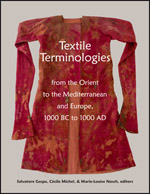Centre for Textile Research
Date of this Version
2017
Document Type
Article
Citation
In Textile Terminologies from the Orient to the Mediterranean and Europe, 1000 BC to 1000 AD, ed. Salvatore Gaspa, Cécile Michel, & Marie-Louise Nosch (Lincoln, NE: Zea Books, 2017), pp. 288-294.
doi:10.13014/K29K48CG
Abstract
A particular language consists of course not only of words inherited from its respective parent language but contains also a certain amount of loan words (however, this amount differs depending on the respective language). This universal principle then also holds true for the speakers of the Germanic languages. The vocabulary of the Germanic languages includes not only the lexicon inherited from Proto‑Indo‑European but a range of languages later on heavily influenced it. In the times before the documentation of the Germanic languages, the two most important sources that influenced the Germanic lexicon were Celtic and (prolonged) Latin. Influence in the lexicon is found in nearly every part of the daily life vocabulary, ranging from words for food and beverages via commercial products to Christian terminology. These borrowings of words in the most cases took place together with the objects or concepts themselves. The research paradigm that investigates these kinds of correlations between words and the underlying objects or concepts is best summarized under the term ‘Wörter und Sachen’
One of the fields, where (due to e.g. new techniques, materials, temporary fashions) a priori a high amount of borrowings of objects (and concepts) is to be expected, is the lexical field of textiles and the terminology used for textile production. A detailed analysis of the vocabulary used for textiles and the techniques in the older Germanic languages is largely missing. In the following, a survey of the vocabulary that denotes textiles in the Old High German language will be carried out in order to answer the following questions:
• What is the proportion between inherited and borrowed terms for clothes and fabric in Old High German and in which areas are the respective groups mostly concentrated?
• In what time can the highest influence be found and from which origin is this influence?
• In what lexical fields are the loanwords found?
• Can the integration of different loanwords in Old High German be determined?
• Are there examples of several inherited and borrowed words for the same concepts and how do they compete?
Included in
Ancient History, Greek and Roman through Late Antiquity Commons, Art and Materials Conservation Commons, Classical Archaeology and Art History Commons, Classical Literature and Philology Commons, Fiber, Textile, and Weaving Arts Commons, Indo-European Linguistics and Philology Commons, Jewish Studies Commons, Museum Studies Commons, Near Eastern Languages and Societies Commons, Other History of Art, Architecture, and Archaeology Commons


Comments
Copyright © 2017 Salvatore Gaspa, Cécile Michel, & Marie-Louise Nosch. Photographs copyright as noted.